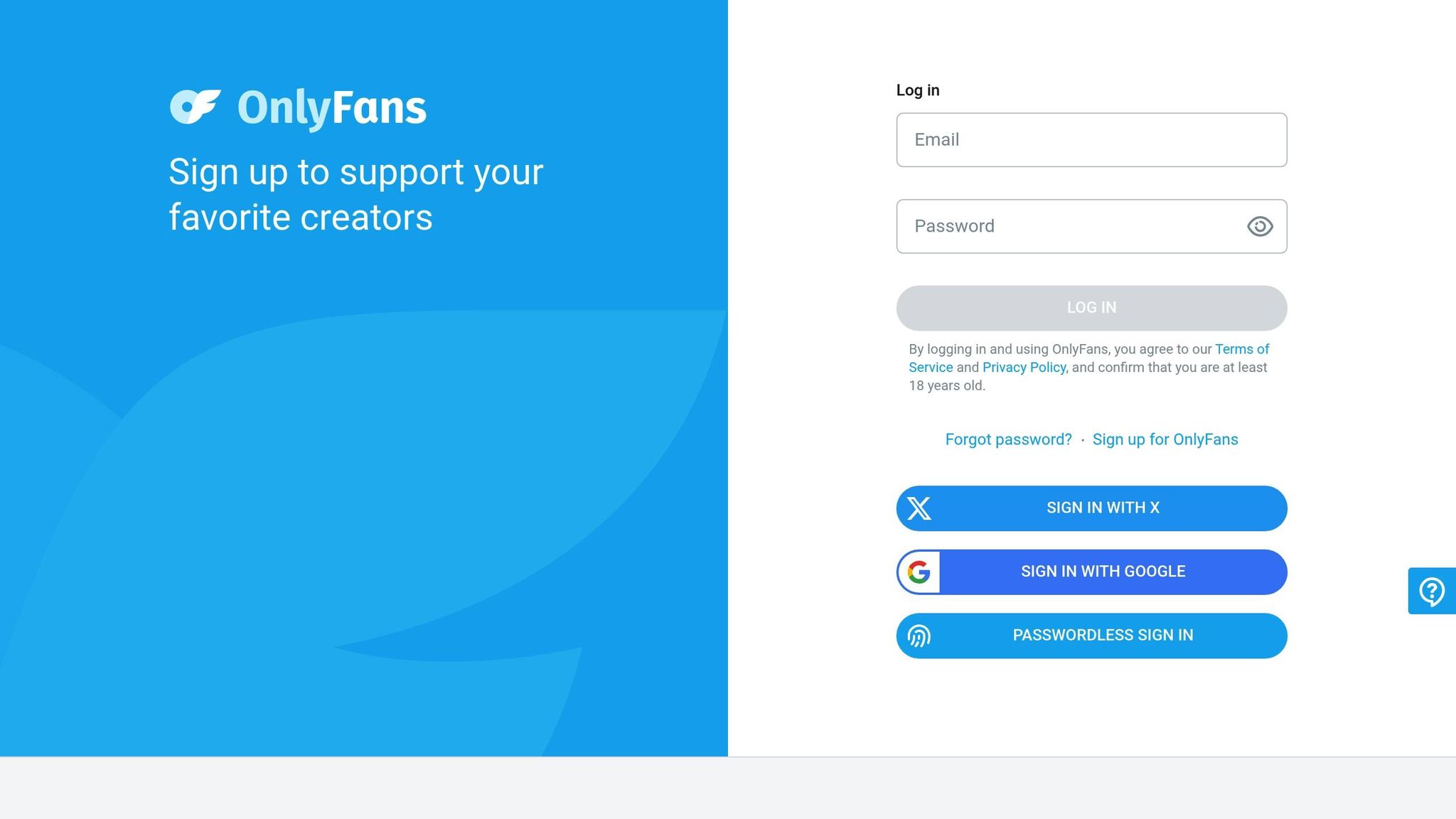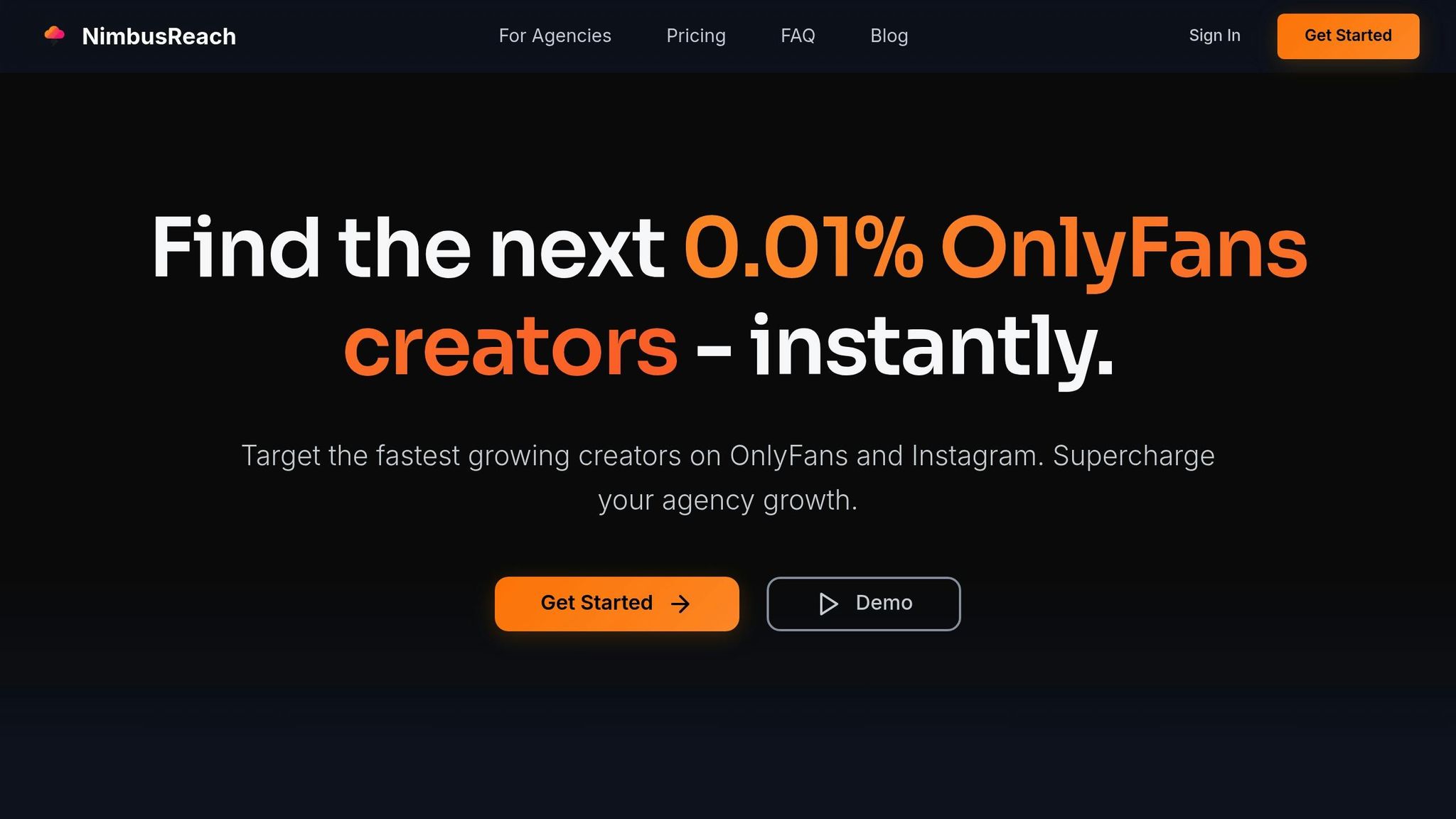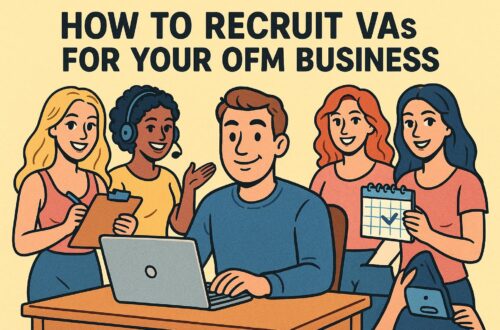OFM (OnlyFans Management) marketplaces connect OnlyFans creators with agencies and tools to help with marketing, fan management, and revenue growth. They simplify business management for creators but come with risks due to the lack of regulation. Here’s what you need to know:
- What they do: These platforms link creators with agencies offering services like marketing, content scheduling, and revenue optimization.
- How they work: Creators can browse services or post needs, while agencies showcase expertise. Payment models include flat fees or revenue-sharing.
- Risks: Many platforms are unregulated. Creators face potential financial loss, poor service quality, or restrictive contracts.
- How to verify:
- Check for clear terms, verified profiles, and transparent pricing.
- Look for reviews and test customer support.
- Verify security measures like SSL encryption and trusted payment processors.
- Choosing tools/agencies: Look for proven results, clear communication, and advanced analytics. Avoid vague promises or hidden fees.
Research thoroughly to avoid pitfalls and protect your earnings.
How to Spot a Good OnlyFans Management Agency in 2023!

How to Check if a Marketplace is Legitimate
When navigating the unregulated OFM marketplace, it’s crucial to separate trustworthy platforms from questionable ones. Without industry oversight, you’ll need to do some digging to ensure a platform is legitimate.
Signs of a Trustworthy Platform
A well-designed and functional website is often the first indicator of legitimacy. Reliable platforms have clean layouts, easy-to-use navigation, and clearly presented information about their services. Look for detailed "About Us" sections, transparent contact details (like physical addresses), and professional customer support options.
Clear terms of service and privacy policies are must-haves. These documents should be easy to find and explain user rights, platform responsibilities, and how your data is handled. Pay close attention to how the platform protects creator information and resolves disputes.
Verified user profiles and credentials show that a platform takes vetting seriously. Look for verification badges, ratings systems, or other signs that users and agencies are thoroughly screened.
Transparent pricing structures are another hallmark of a legitimate platform. All costs – such as commission rates, listing fees, and any other charges – should be clearly outlined. Legitimate platforms also explain their payment processes and how they handle disputes.
Active community engagement and regular updates are good signs, too. Check for recent blog posts, social media activity, and platform updates that demonstrate ongoing effort and user support.
Steps to Verify a Platform’s Legitimacy
Start by researching the company behind the platform. Many U.S. states provide public access to business registration records through secretary of state websites. Legitimate companies will have proper licenses and registered addresses. Cross-check this information with what’s listed on their website.
Look for online reviews and testimonials from creators. Go beyond the platform’s own testimonials and check independent sources like forums, social media, and review sites. Pay attention to recurring complaints or praise, and be cautious of platforms with only overly positive or uniform reviews.
Test their customer support before making any commitments. Reach out through various contact methods and evaluate their response times and the quality of their answers. Legitimate platforms typically respond within 24–48 hours with clear and helpful information.
Review their security measures. Check for SSL certificates (the padlock icon in your browser), secure payment processing, and clear data protection policies. Legitimate platforms often use trusted payment processors like Stripe or PayPal instead of relying on direct bank transfers or cryptocurrency.
Evaluate their user base and activity levels. A legitimate platform will have active listings, frequent user activity, and a growing community. Be cautious of platforms with outdated listings, minimal activity, or agencies that seem too good to be true.
Here’s a quick comparison of trust factors:
Comparison Table of Trust Factors
| Trust Factor | Legitimate Platform | Red Flag Platform |
|---|---|---|
| Business Registration | Verifiable company info, registered address | No verifiable info, P.O. box addresses only |
| Payment Methods | Trusted processors (Stripe, PayPal), escrow services | Direct bank transfers, cryptocurrency only |
| User Verification | Multi-step verification, documentation required | No verification process, open to anyone |
| Customer Support | Multiple contact options, quick responses | Limited options, slow or no responses |
| Pricing Transparency | Clear fees, detailed breakdowns | Hidden or vague fees, "contact for pricing" |
| Security Features | SSL encryption, secure payments, privacy policies | No SSL, unsecured payments, missing policies |
Taking the time to verify these factors before sharing your personal information or creating an account can save you from potential headaches. Legitimate platforms prioritize transparency and aim to build trust with their users over the long term.
How to Judge Tool and Agency Quality
Once you’ve confirmed the legitimacy of a marketplace, the next step is to evaluate the quality of agencies and tools. This ensures you don’t waste your time or money on subpar options.
What to Look for in Agencies and Tools
When assessing agencies, focus on those that have a track record of measurable success – whether that’s growth in followers, increased revenue, or higher engagement rates. The best agencies can show consistent results over time, not just one-off successes.
A few key factors to consider include:
- Proven Results: Look for agencies that can back up their claims with data and case studies.
- Comprehensive Services: Agencies offering a wide range of services, from content creation to customer support, are often better equipped to handle complex campaigns.
- Specialized Expertise: Top-performing agencies employ experts in areas like social media management, data analysis, and customer service. These specialists stay on top of industry trends and adapt quickly to platform updates.
- Advanced Analytics: Agencies that use cutting-edge tools to track performance and identify growth opportunities tend to deliver better results. They should be transparent about their analytics process and how they use data to guide decisions.
- Clear Communication: Regular, detailed reporting is essential for tracking progress and ensuring alignment on goals.
These criteria set the standard for evaluating any agency or tool.
How NimbusReach Stands Out

NimbusReach addresses common challenges in the OFM space with a data-driven approach. One of its standout features is the proprietary Fan Devotion Score, which identifies creators who have genuine, paying fans. This helps agencies focus their efforts on partnerships with real revenue potential.
Key features of NimbusReach include:
- Advanced Search and Filtering: Agencies can refine searches based on niche, earnings potential, and engagement levels, saving time and improving accuracy.
- Real-Time Growth Alerts: Notifications about trending creators and new opportunities allow agencies to act quickly.
- Bulk Export Tools: These tools simplify the process of organizing and tracking large numbers of potential creators, streamlining workflows.
- Content Ideation Tools: With data-backed suggestions, agencies can develop content strategies that are both engaging and profitable.
By combining these features, NimbusReach supports sustainable growth and helps agencies make smarter, faster decisions.
Feature Comparison Table for Tools and Agencies
The table below highlights the differences between basic, advanced, and premium tools to help you make an informed choice.
| Feature Category | Basic Tools/Agencies | Advanced Tools/Agencies | Premium Platforms (e.g., NimbusReach) |
|---|---|---|---|
| Analytics Depth | Basic performance metrics | Detailed analytics with multi-platform data | In-depth analytics with a proprietary Fan Devotion Score |
| Search Capabilities | Manual browsing and basic filters | Customized filters by category | Advanced search by niche, earnings, and engagement |
| Data Export | Limited CSV downloads | Bulk exports with standard formatting | Streamlined bulk exports for efficient workflow |
| Growth Tracking | Manual monitoring | Automated alerts for top performers | Real-time notifications and trend analysis |
| Support Level | Email support with slower response | Multiple support channels during business hours | Dedicated support with priority response |
| Pricing Model | Per-creator fee or flat monthly rate | Tiered plans with usage limits | Flexible pricing that scales with agency needs |
The main distinction between basic and premium solutions lies in automation and data sophistication. Basic tools often require manual effort and provide limited insights, while premium platforms like NimbusReach automate discovery and analysis, offering deeper, more actionable information.
When choosing a tool, consider how its features align with your specific goals. Solo marketers may find basic tools sufficient, but agencies looking to scale will benefit from the efficiency and insights provided by premium platforms. Investing in the right tools can lead to better results and stronger partnerships with creators.
sbb-itb-bd3d2dc
Pricing Models and How to Calculate Value
OFM marketplaces use pricing structures designed to ensure you only pay for the features you actually need. Many platforms offer tiered monthly subscription plans, giving you predictable costs based on your usage.
Types of Pricing in OFM Marketplaces
Most OFM marketplaces operate on a monthly subscription model. These plans typically include a set number of creator profile views or searches per month. For instance, you might pay $50.00 per month to access 1,000 creator profiles. This setup is ideal for agencies and marketers who regularly reach out to creators.
What Each Price Level Includes
Pricing tiers come with varying features, so understanding what each level offers can help you select the right plan without overspending.
- Entry-level plans: Priced between $25.00 and $50.00 per month, these plans cover the basics. For example, NimbusReach’s Starter plan costs $25.00 monthly and includes 250 profile views, advanced search filters, and basic export tools – perfect for solo marketers or small teams.
- Mid-tier plans: Typically around $50.00 per month, these plans offer features that simplify workflows. NimbusReach’s Growth plan, for example, provides 1,000 profile views, growth alerts for trending creators, and bulk export tools, making it a practical option for agencies managing multiple creator relationships.
- Premium plans: Ranging from $100.00 to $200.00 per month, these options include advanced analytics and priority support. NimbusReach’s Pro plan, priced at $150.00 per month, offers 5,000 profile views, dedicated support, and content ideation tools. These higher-tier plans are ideal for more complex outreach and save time with added automation and insights.
Once you’ve chosen a plan, the next step is to evaluate the return on your investment.
How to Calculate Return on Investment
Maximizing ROI is all about balancing costs with outcomes. For OFM marketplace tools, this means focusing on the quality of the creators you connect with rather than just the quantity of profiles accessed. Start by calculating your cost per successful partnership. For example, if you spend $150.00 per month and secure three partnerships, each generating $2,000.00 in revenue, your cost per partnership is $50.00.
Time savings also play a big role in ROI. Researching creators manually can take hours, but advanced platforms significantly cut this time with automated filters and analytics.
Metrics like the Fan Devotion Score can also help you identify creators with genuinely engaged audiences, avoiding those with inflated follower numbers. Additionally, tracking your conversion rate – from initial outreach to successful partnerships – can show how better data leads to real cost savings. Measuring ROI over several months often paints a clearer picture of the long-term benefits as partnerships grow and deliver results.
Smart Buying Tips and Warning Signs
Navigating the OFM marketplace wisely means paying attention to key factors and knowing how to spot potential red flags. These tips and cautionary signs complement earlier advice for ensuring a secure experience in the marketplace.
Best Practices for U.S. Buyers
Start by confirming that the marketplace complies with U.S. regulations. Stick to platforms that hold verified U.S. licenses.
When assessing an agency’s credentials, look for third-party audited financials. This transparency signals a commitment to sound financial practices.
Choose platforms with SOC2 Type II or ISO/IEC 27001 certifications. Also, check their history for any security breaches or prolonged withdrawal delays.
Carefully review contract terms to uncover hidden fees or payout thresholds. If anything seems unclear, ask for clarification before agreeing to terms.
Leverage independent review platforms, like Trustpilot, to gather unbiased feedback. Look for recurring themes in reviews to identify both strengths and potential issues.
Warning Signs to Watch Out For
Certain warning signs should make you think twice about a marketplace’s reliability. Unrealistic performance claims, such as guarantees of specific earnings without solid evidence, are a major red flag.
A lack of transparency is another issue to watch for. If a platform avoids disclosing key business details or provides vague explanations about its data sources, it may not be trustworthy.
Pay attention to data quality. Inflated or error-ridden creator statistics, especially when the platform can’t explain its data collection methods, suggest questionable practices.
Be wary of platforms that lure you in with appealing base prices but tack on hidden fees later. Always ask for a detailed fee breakdown upfront.
Quick Reference Table of Tips and Warning Signs
Here’s a handy table summarizing the key best practices and red flags for U.S. buyers:
| Best Practices | Warning Signs |
|---|---|
| Verify regulatory compliance and licensing | Unrealistic performance claims |
| Look for third-party audited financials | Lack of transparency in operations |
| Choose platforms with SOC2 or ISO/IEC 27001 certifications | Poor-quality or inflated data |
| Review contract terms for hidden fees | Vague explanations about data sources |
| Cross-check reviews on trusted platforms | Unexpected or undisclosed charges |
| Request a full fee breakdown | |
| Confirm company leadership and physical address |
Reputable platforms are open to scrutiny and should readily answer questions about their security protocols, data accuracy, and business practices. If a platform becomes evasive or defensive when questioned, treat that as a serious warning sign. Combine these tips with earlier guidance on platform verification and ROI to protect your investments effectively.
Key Points to Remember When Buying from OFM Marketplaces
Making informed decisions when purchasing from OFM marketplaces calls for careful research and thoughtful evaluation. Start by checking the platform’s credibility – look into its security measures, business practices, and level of transparency.
When comparing tools or agencies, don’t just focus on the upfront price. Be sure to consider ongoing fees, operational expenses, and any hidden charges. The features should align with your business needs, offering dependable security and smooth software functionality.
It’s also essential to review the level of support provided. Look into service agreements and performance guarantees to ensure you’re getting long-term value. Having direct conversations with providers can also give you insight into their expertise and reliability.
Consider how the engagement model – whether subscription-based, project-based, or retainer – affects both your finances and operations. Planning for the long term is key to maximizing value. Alongside these considerations, stay alert to potential red flags.
Be cautious of unrealistic promises, vague pricing or business practices, and poor data quality. If a provider seems evasive about their operations, it’s a sign to reassess. These warning signs, paired with your initial legitimacy checks, will help you make choices that align with your goals and expectations.
FAQs
How can I protect my personal and financial information when using an OFM marketplace?
To keep your personal and financial details safe while using an OFM marketplace, start by choosing a platform with a solid reputation and strong security measures. Check if the marketplace uses encryption to safeguard sensitive information and clearly outlines its privacy policies.
Be cautious about the personal information you share – only provide what’s absolutely necessary. Use strong, unique passwords for your accounts, and if the platform offers two-factor authentication (2FA), make sure to enable it for extra protection. It’s also a good idea to keep an eye on your financial statements for any unusual activity and stick to trusted payment methods.
By staying alert and taking these precautions, you can greatly minimize the chances of fraud or data breaches on these platforms.
How can I determine if an agency on an OFM marketplace can deliver the marketing and growth results I need?
When choosing an agency to handle your marketing and growth needs, it’s important to look at a few key factors: their onboarding process, ability to grow with you, and how realistic their promises are.
An agency with a strong onboarding process is more likely to attract top talent and get your partnership off to a smooth start. This step is crucial for setting the tone and ensuring everything runs efficiently from day one.
You’ll also want to see if the agency can expand its services as your business grows or if they can adapt to new challenges. Flexibility is essential for meeting both your current needs and future goals.
Finally, watch out for agencies that make bold claims, like guaranteeing specific results. Success often depends on multiple factors, many of which are outside their control. Evaluating these elements carefully can help you find an agency that aligns with your objectives.
What should I consider when comparing pricing models on OFM marketplaces?
When exploring pricing models on OFM marketplaces, it’s important to pay attention to a few critical aspects to make the right decision for your needs. Start by examining what’s included in the pricing structure – does the cost cover full-service management, access to specific tools, or just basic support? The pricing should match the level of service you’re looking for.
Next, think about how the pricing is set up – is it a flat fee, a subscription, or a percentage of your earnings? Flat fees can provide consistency, while percentage-based models might adjust as your income grows. Lastly, weigh the value you’re getting for the cost. Compare the price to the potential benefits, like higher revenue or time savings. Be sure to look for clear, upfront pricing and steer clear of any hidden fees to make a well-informed choice.
Related Blog Posts
- How to start an OnlyFans Agency – Step by Step
- 7 Things To Do Before Starting Your OnlyFans Agency
- Is Starting an OnlyFans Agency Worth It? What New Managers Need to Know The Complete OnlyFans Agency Business Model Explained Top 10 Mistakes Beginners Make When Starting an OnlyFans Agency
- OnlyFans Agency Success Stories: Lessons From Top Agencies





